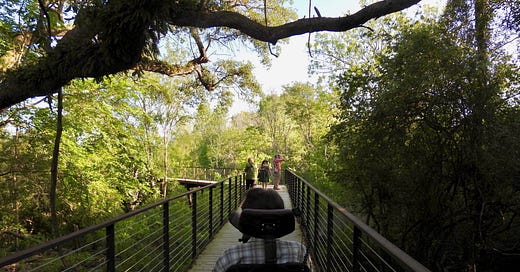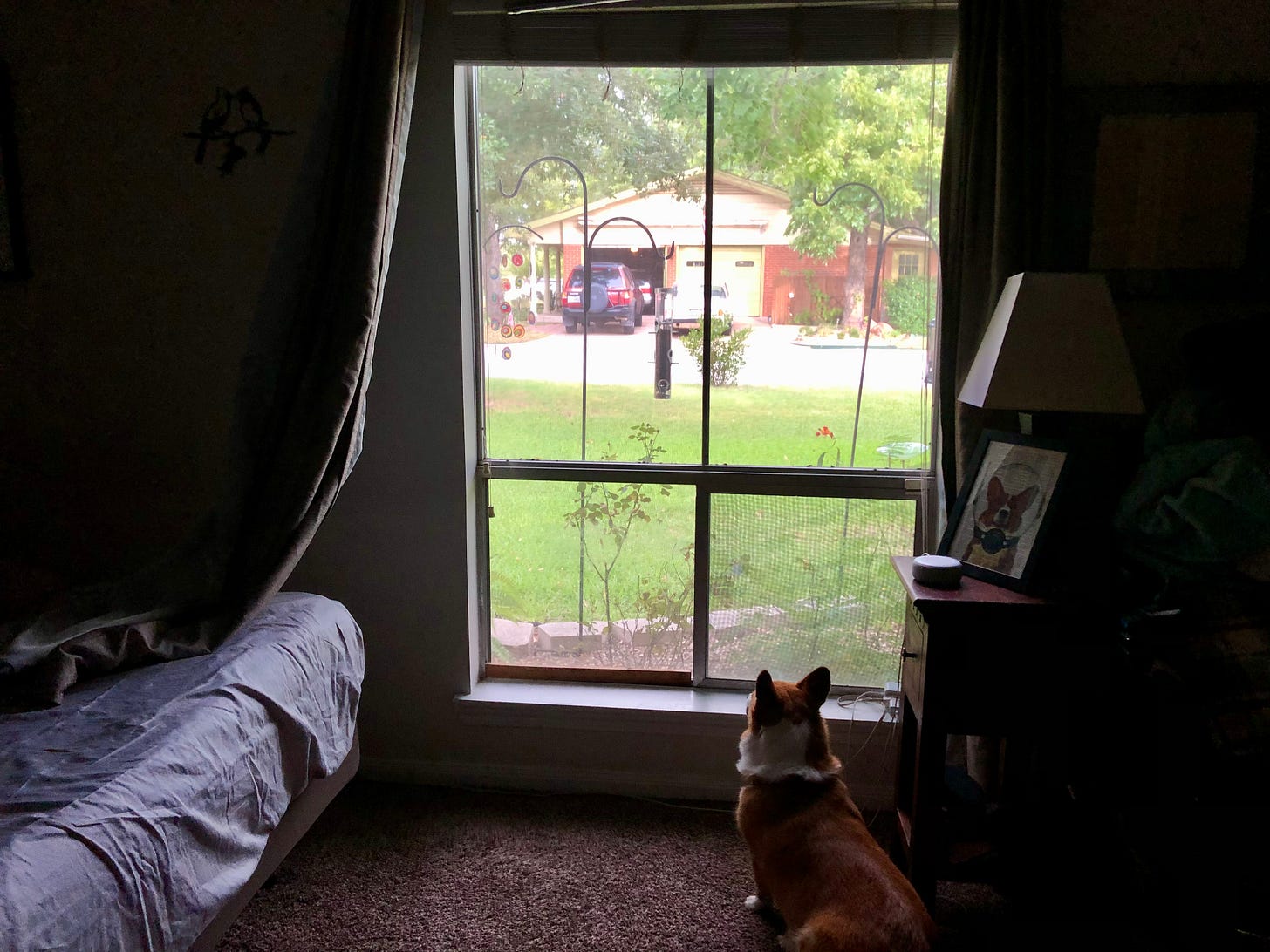Dear Friends,
It pains me to say I am not on the coast this week. Those who read part one of my Vermilion Flycatcher story know that this is not the first trip I’ve canceled this year. It’s the third. Such cancellations are among the many changes my condition has foisted on me in the last few months.
I permit a mere sliver of grief in these newsletters because I am still processing it. If my newsletters read like the positive affirmations of a man who has gracefully accepted his limitations, it is only because the act of writing them has diminished my grief. And which is why my gratitude for your readership comes from the deepest pit in my heart.
A Trip in Memory
Our adventure was to begin on Galveston Island, exploring the migratory offerings of a four-day birding and nature photography festival. Then we were to take a ferry and arc up Bolivar Peninsula to High Island, a birder’s paradise and my favorite place on Earth.
A tiny town with 500 residents, High Island boasts some of the best birding in the country. Its woods are a haven for songbirds who weather the long hazardous flight across the Gulf of Mexico each spring.
If the passage is particularly stormy, the birds may drop, quite literally, to the ground—a spectacular phenomenon known as “fallout.” The survivors then rest and refuel, for an audience of birders, in the town’s four sanctuaries.
Just a mile south, the ocean hosts its own avian delights: gulls and terns, skimmers and shorebirds. Follow the coastline, and you reach Bolivar Flats, where you can drive on the beach and watch hundreds of American Avocets from the comfort of your car.
Head north from High Island, and just beyond the intracoastal waterway is a vast coastal prairie. Red-winged Blackbirds and Eastern Kingbirds bob on roadside reeds. Swainson’s Hawks perch on power poles as Northern Harriers cruise low over the grasslands.
Tear west ten miles, and you arrive at Anahuac National Wildlife Refuge, where Fulvous Whistling-Ducks bathe in the company of alligators. When rain looms in the golden light, it can feel like the Serengeti.
This incredible diversity of birdlife, all centered around High Island, is, of course, a major draw. But so, too, is the accessibility. At Smith Oaks, a fresh boardwalk rises 17 feet into the canopy, bringing you eye-level with birds and obviating the use of binoculars. The boardwalk splits, with each end terminating in an overlook, where you can observe the nesting habits of hundreds of herons, spoonbills, and other water birds.
At Boy Scout Woods, a few blocks away, bleachers face a rich forest habitat with a watering hole for birds. It’s a popular spot for thrushes, tanagers, and warblers. You can sit in the peaceful, near-silent woods, watching as each bird poses in the understory, at times as close as six feet away! Or, you can wander into the adjacent thicket on an accessible boardwalk.
For Texas birders, High Island is akin to a spiritual center, a veritable Mecca on the Gulf Coast. We pilgrimage there every April during our holiest time of year. As a birder with a disability, High Island represents my best annual chance to see a ton of species with minimal physical effort. In a weekend, I can catch a year's worth of birds.
Missing High Island in April feels unthinkable to me, but it’s a symptom of an inevitable decline, one we’ll all experience if we live long enough. Sliding deeper into this new reality, I realize that my next great adventure is an inward one. I won’t be chasing birds so much as memories, flitting in the shadows of leaves.
The Good Life Is Here
For days I deliberated over canceling our trip. I ultimately sought the counsel of my mother-in-law. She’s something of a ref in our household, the elder we ask to break our ties. “If we don’t go now, I won’t see these birds again until next year,” I groaned. “But, if we go, and I overdo it, I might not ever get to go again.”
“This is the good life,” she said. Her words were soft, yet surprising. She was referring to the beautiful home we’ve made in Austin. “One day you and Nicole will look back and say, ‘this was the good life.’ Sitting in the backyard, taking the dogs for walks. This is the good life right here.”
But the birds at High Island don’t come here, I wanted to explain. Yet, the truth of her words rendered me speechless.
A warbler was singing outside my bathroom the morning we were supposed to leave. It was a typical warbler song, a series of two-part phrases with a trill at the end, but I didn’t recognize the species. My care attendant opened the window as I hit record on Merlin Sound ID. The answer popped up immediately: Nashville Warbler! It was a new species for the yard and the first I’d heard its song.
But the joy of adding a new bird to the yard list was swiftly overshadowed by an even greater discovery. It was a sweet, whistling song, quiet, with phrases so spaced apart that it almost went unnoticed in the cacophony of grackles and mockingbirds. Merlin identified this mystery bird as a Blue-headed Vireo.
I was astonished. Not only was this the first vireo of any kind to visit our yard. It was a life bird—my first of the year, in fact—and I didn’t need to venture farther than my toilet to find it! In awe I watched the spectrogram, the string of upcurves and down-slurs appearing like hieroglyphics.
This song was far from a consolation prize. It was a message I would’ve wholly missed had we been hurtling toward the coast: the good life is here.
I wrote the following poem in 2020 when my days were spent at our bedroom window, observing the lives of our neighbors from a safe distance. But really, it’s about the blessings that make our lives full. Even when our challenges seem insurmountable, our blessings can keep us grounded in gratitude and wonder.
Enjoy the poetry,
Eric
PS: Here’s a rough recording of that Blue-headed Vireo singing. I cranked the volume to make sure it was clear, so you might want to lower your volume before hitting play.
Window Watching I spent the morning watching the big screen that faces onto our street. The first channel showed a slim older man with Mad Max goggles shielding his eyes and a terrier stopping to pee on our mountain laurel. I did not care for that show, so I flipped the channel, settling on our landscape-savvy neighbors: she mowed, he whacked, she blew, he bagged. But my mind wandered. Why must we all have lawns? Why not switchgrass, bluestem, mustard? Again I changed the channel, landing on the succulents in the planter your mother hung outside the window— their jagged shapes like the prehistoric spikes at the end of a stegosaurus’s tail, pink and pastel green. You might not know this about me but I once memorized the names of all the dinosaurs, and adorning my wall until the age of 16 was a subway poster of an angry T-Rex baring teeth as it tore through the woods. Snapped branches flew like toothpicks through the air all about the sides of its massive head. Hiding on the bottom bunk beneath the zebra pattern comforter I would stare down that monster as sleep took hold. That room had a TV too—though not as big as ours— and beyond the screen a driveway snaked up to a basketball hoop where I played an NBA championship every week, and an olive tree stood as the prized treasure of the yard. I could not see past the privet hedge, but I could hear the neighbors return from work or with their kids: their cars parking, emergency brakes ratcheting, doors opening and slamming shut as kids relived school for their parents. The programming was similar to ours but rather than a premium package, we had basic cable. In lieu of endless stream-able entertainment we had to tune in at a specific time if we wanted to catch something good. One day I would like to watch our TV from the outside: to see our days unfold on the edge of our seats, inviting friends over for the season premieres and finales, pulling fistfuls of buttered popcorn from a bowl we pass around the yard. Perhaps our series would endure for decades, become something of a cultural phenomenon— the perfect representation of this era— and maybe when the screen would darken that final time, in the split second before the credits roll, our neighbors would gather in the street before our house to applaud this magnificent show.
Keep reading with a 7-day free trial
Subscribe to Bird City News to keep reading this post and get 7 days of free access to the full post archives.






